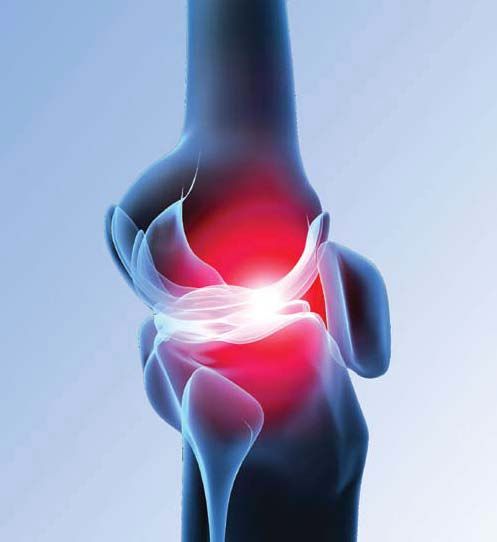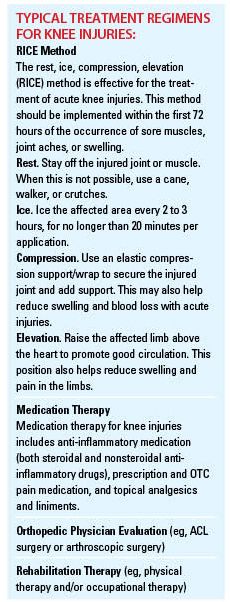Publication
Article
Pharmacy Times
Knee Injuries: Helping Patients Treat the Pain
Common knee injuries are responsible for 20 million physicians' office visits annually. Pharmacists are in a key position to help patients with knee injuries understand their condition and manage their pain.

Each year there are approximately 20 million visits to physicians’ offices because of knee injuries. It is also the most common reason reported for visiting an orthopedic surgeon. No other joint in the human body is as large, or as important, for smooth, powerful, and elegant movement, as the knee. With every running stride or landing from a jump, the knee absorbs and diffuses forces equivalent to 8 to 10 times an individual’s body weight. It coils when one pivots, allowing the foot to point in one direction and the trunk in another. It is a weight-bearing joint that straightens, bends, twists, and rotates. All of these movements increase one’s risk of acute or chronic knee injuries, a source for pain for millions.1-3
Structure of the Knee
The knee performs multiple tasks perfectly because just below the skin lies a lattice network of ligaments and tendons that weaves together multiple muscles and bones. The knee actually consists of 3 bones: the lower end of the thighbone (femur), the end of the shinbone (tibia), and the knee cap (patella). Articular cartilage is a type of slick, hard, bonelike, flexible, white connective tissue that covers the surface ends of the tibia and femur to reduce friction and allow bones to move easily against each other. Meniscus, another important structure in the knee, is a soft, tough,rubbery, crescent-shaped wedge, similarto a shock absorber, between the femur and tibia bones. Meniscus helps distribute the weight of the body across the knee joint, lubricates and protects the articular cartilage from wear and tear, stabilizes the knee when one slides and turns, and limits extreme knee flexion and extension. There are 2 types of meniscus: The lateral meniscus slides forward and backward, and the medial meniscus helps the anterior cruciate ligament (ACL) and medial collateral ligament (MCL) stabilize the knee, absorbing up to 50% of the load applied to the inside of the knee.
Just behind the kneecap are 4 essential ligaments that connect the femur and tibia: 1) the MCL runs along the inside of the knee joint and provides stability to the medial (inner) part of the knee; 2) the lateral collateral ligament (LCL) runs along the outside of the knee joint and provides stability to the lateral (outer) part of the knee; 3) the ACL is in the center of the knee and limits rotation and forward leg movements; and 4) the posterior cruciate ligament (PCL) is in the center of the knee and limits backward leg movements.
Large upper leg muscles, the quadriceps, provide the leg with mobility and strength and enable straightening of the legs. The patella tendon protects the bones and soft tissue in the knee joint and slides when the knee moves, giving leverage to the leg muscles. The quadricepstendon hooks quadricep muscles to the patella and joins the patella tendon to form one continuous tendon surface that covers the patella. The hamstring muscles help the knees bend.
Common Knee Injuries
Some knee injuries (eg, muscle strain, tendonitis, bursitis) may result from overuse or overload and may develop gradually over days or weeks. Pain due to inflammation is often mild and intermittent in the beginning and intensifies over time. Knee pain is commonly caused by trying to do “too much too soon,” especially highimpact activities (eg, aerobics, brisk walking, running or jumping on hard surfaces or uneven ground, and excessive running up and down stairs), when one has not exercised for a long period of time. When muscles and tendons are stressed even slightly beyond their capabilities, micro- scopic tears can occur. These tears must be given a chance to heal before being subjected to vigorous activity to avoid overuse injury and pain.
Cartilage Injuries
Articular cartilage injuries may occur as a result of other physical injuries. The term “torn cartilage” in the knee usually refers to a torn meniscus, or meniscus cartilage injury. Meniscal tears are among the most common knee injuries. These tears may occur from a squatting, quick twisting, cutting, pivoting, or decelerating of the knee, or from forceful physical contact. When menisci are aged or weakened, an awkward twist when getting up from a chair may be enough to cause a tear. Older individuals are more likely to have degenerative meniscal tears. Athletes who play contact sports are also at risk for meniscal tears.
An individual may feel a “pop” when he or she tears a meniscus. Most individuals can still walk on the injured knee and continue activities. Over the next 2 to 3 days, the knee will gradually become swollen, red, stiff, and painful. One may experience catching of the knee, the sensation of the knee “giving way,” and the inability to move the knee though its full range of motion. Without treatment, a piece of the meniscus may detach and drift into thejoint, causing the knee to slip, pop, or lock. Individuals should seek treatment as soon as possible, especially if they hear a popping noise and feel the knee give out at the time of injury, have severe knee pain or swelling at the injury site, or cannot move the knee or begin limping.
Ligament Tear Injuries
Ligament tear injuries are common injuries among active individuals/athletes. Of the 4 major ligaments found in the knee, the ACL and the MCL are most often injured in sports or by physical stress. PCL injuries occur less often. In general, torn ligaments are caused by twisting the knee or falling. Individuals at high risk include those participating in sports, including sports that involve running, jumping, and sudden stopping. Sports during which participants make sharp, abrupt changes in direction—such as soccer, basketball, volleyball, tennis, and baseball, as well as contact sports such as football, wrestling, and hockey—put individuals at risk for injury and pain.
ACL Injuries: “Blowing Out” theKnee
ACL injuries can occur as a result of rapidly changing direction, abruptly slowing down when running, and forcefully landing from a jump, which may cause tears in the ACL. Men and women athletes who participate in skiing or basketball, or those who wear shoe cleats, such as football players, are very susceptible to ACL injuries. When the ACL is torn, a loud signature pop is heard, followed by intense pain and immediate swelling of the knee joint.
MCL and PCL Injuries
Injuries to the MCL are usually caused by a severe, direct blow to the outside of the knee. These types of injuries often occur in contact sports, such as football, soccer, and skiing. PCL injuries may occur when an athlete receives a hard blow to the front of the knee or makes a simple misstep on the playing field.
Runner’s Knee
Runner’s knee (patellofemoral pain or anterior knee pain) is a common cause ofknee pain in younger people. It accounts for approximately 25% of all knee injuries. Runners, cyclists, dancers, and basketball, soccer, and tennis players are at higher risk for runner’s knee. The affectedindividual usually experiences diffusepain behind the kneecap. Symptoms often worsen after climbing stairs, jumping, running, or a period of sitting.
Arthritis
Although not technically a sports injury, continual use of the knees over time may lead to some degree of degenerativearthritis, or osteoarthritis (OA). Knee OA is a common cause of knee pain. The risk of OA increases with age and knee usage. This

condition occurs when the articular cartilage at the end of femur and fibia bones wears away and the bone-end surfaces roughen. Bone or cartilage fragments can also break off inside the joint capsule and float in joint fluids. Either problem can limit movement and cause mild to severe pain.
Treatment of Knee Injuries
Treatment regimens for knee injuries must be individualized to the type and severity of the injury and often involve a combination of different treatment methods. To repair ACL injuries in an active athlete, ACL surgery and a lengthy rehabilitation period of 6 to 9 months are often required. Many other knee injuries can be successfully treated with medication and rehabilitation.
Typical Treatment Regimens for Knee Injuries:
RICE Method
The rest, ice, compression, elevation (RICE) method is effective for the treatment of acute knee injuries. This method should be implemented within the first 72 hours of the occurrence of sore muscles, joint aches, or swelling.
Rest.
Stay off the injured joint or muscle. When this is not possible, use a cane, walker, or crutches. Ice. Ice the affected area every 2 to 3 hours, for no longer than 20 minutes per application.
Compression.
Use an elastic compression support/wrap to secure the injured joint and add support. This may also help reduce swelling and blood loss with acute injuries.
Elevation.
Raise the affected limb above the heart to promote good circulation. This position also helps reduce swelling and pain in the limbs.
Medication Therapy
Medication therapy for knee injuries includes anti-inflammatory medication (both steroidal and nonsteroidal antiinflammatory drugs), prescription and OTC pain medication, and topical analgesics and liniments.
Orthopedic Physician Evaluation
(eg, ACL surgery or arthroscopic surgery)
Rehabilitation Therapy
(eg, physical therapy and/or occupational therapy)
Final Thought
For patients with knee injuries, the resulting pain can range widely, from mild and acute to severe and chronic. Pharmacists can be instrumental in helping these patients find appropriate methods to reduce the inflammation and pain from knee injuries.
References:
1. Reynolds, G. The complete guide to your knee. March 2010; 53-63.
2. Koopman, William, et al., eds. Clinical Primer of Rheumatology. Philadelphia: Lippincott Williams & Wilkins, 2003.
3. Kelley's Textbook of Rheumatology, W B Saunders Co, edited by Shaun Ruddy, et al., 2000.
4. Kastrup EK. Facts and Comparisons. Facts and Comparisons (Firm), St. Louis, MO. 2010.
5. Safe use of OTC topical anesthetics. Pharmacist’s Letter/Prescriber’s Letter 2009;25(3):250314.
6. Lambertz CK, Johnson CJ, Montgomery PG, Maxwell JR. Premedication to reduce discomfort during screening mammography. Radiology 2008;248:765-725.
Mr. Brown is a clinical pharmacist at Clarian Arnett Hospital and professor emeritus of clinical pharmacy at the Purdue University School of Pharmacy in West Lafayette, Indiana.







